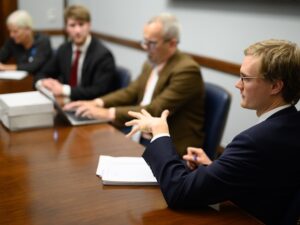What does it mean to electrify everything?
By Berit Thorson
On April 9, Keishaa Austin spoke at CCL’s monthly call on behalf of Rewiring America, a nonprofit organization “focused on electrifying everything in our communities.” Keishaa is Rewiring America’s Head of Engagement and Partnerships, and on the call, she discussed the case for electrifying everything and what it would look like for individuals to move toward electrification of their households.
Keishaa joined Rewiring America after working with the California Public Utilities Commission where she worked on the commission’s Distributed Energy Resources’ Action Plan 2.0. Rewiring America was co-founded by Saul Griffith and Alex Laskey, both of whom are entrepreneurs of their own separate businesses, as well. Rewiring America is working on “decarbonizing our world fast enough to limit global warming to 1.5 degrees Celsius, [while] ensuring that no household or community is left behind.” The organization hopes to help transition the United States energy sector away from fossil fuels in the next decade, electrifying one household at a time.
In her presentation, Keishaa described Rewiring America’s pitch for why we should electrify everything. Firstly, they “believe that [electrification is] a vibrant solution to the challenges that we’re facing and it will also provide us with a healthy future. And that healthy future includes good paying jobs that can’t be outsourced [which is] super important to the economy… [and] to American families, so that we can see more money going into purchases that make a difference in their lives and their households and protec[t] against volatility.”
Secondly, she says, “We need to pull away from that dependence on petrostate dictators… Not only do we need to be doing that here in the U.S., but we need to be doing it for peace in this world. We’re seeing what’s happening in Ukraine and we understand how necessary it is for us to be electrifying for peace and doing it very quickly so we can move away from those petrostate dictators.” Rewiring America has developed a three-part Electrify for Peace Policy Plan that addresses (1) industrial policy, (2) workforce development, and (3) domestic energy independence. The goals of the plan are to “help Europe reduce its reliance on Russian oil and gas in the medium term” as well as “support lasting energy security in the U.S.” The plan consists of first building U.S. manufacturing capability for various kinds of energy-efficient heat pumps. This is followed by sending civilian volunteers to Europe and the United Kingdom for training in how to install such heat pumps before returning to the U.S. with these new skills in a “rapidly growing U.S. heat pump market.” Lastly, if Congress enacts the full climate package proposed in the budget reconciliation, it will reduce inflation and save U.S. families money on their household electricity bills.
Finally, Keishaa says, electrification is something that everyone can support. She continues, “The whole thing about electrification, to me, is that you can just get an induction stovetop and you’re on your way to electrifying your household. You are putting your foot forward to being part of that climate solution.
“We want to electrify where you work, live, learn, and play. Everything. We want to electrify because it’s inevitable and it needs to happen.” Electrifying everything cannot happen without individual action, of course. Keishaa explains, “What we really need to be talking about is… [people must] get rid of bad machines and swap them out for the good ones, and those are electric appliances.”
Rewiring America says that 1 billion machines need to be replaced with electric versions in order to eliminate household carbon emissions in the United States. This means approximately 50 million machines per year for the next 20-25 years need to be replaced; that comes out to about 500,000 households per month. Machines to replace include water heaters, space heaters, dryers, stovetops, vehicles, and more.

After electrification, the website says, “your home will be more comfortable, your indoor and outdoor air quality will be healthier, [and] your monthly bills will be lower.” Your health, and that of your family, may also be positively impacted. Gas stoves, for example, emit pollutants that contribute to health conditions like asthma, so “electrifying household appliances would address the 42% increased risk of children experiencing asthma symptoms associated with gas stove use.” Rewiring America’s website also has information on how to plan out the electrification process, and what to keep in mind regarding electrification as a homeowner or landlord versus a renter.
In the end, Keishaa says, electrification needs to be a movement that includes everyone. Rewiring America is focused on “building a supportive coalition, and that includes our CEOs for electrification as well as our mayors and municipal leaders… So we’re looking at a federal, state, and local coalition and then… building out our volunteers as well.
“And then what we’re doing, which is super important as well, is educating the public. We want folks to understand that they can be involved. Sometimes people don’t know where to start,” she explains. Rewiring America hopes to invite everyone into the conversation surrounding electrification and “help them be empowered to participate in what we need to be doing here to improve our lives and the lives of our future generations.”
The movement for electrification, just like the climate movement more broadly, starts with each individual person doing what they can, from contacting local officials so their voices are heard to making small changes in their daily lives that build a better future.
Berit Thorson is the CCL Spring 2022 Communications Intern. As an outdoors enthusiast, she is passionate about protecting nature and people from the impacts of climate change, and is excited to be working with CCL toward these goals.








